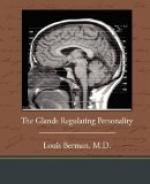That an animal is a vast concourse of cells is one of the accepted fundamentals of biology. What is not so generally taken into consideration is that the assemblage is formed by the agglutinations of millions of years, and that it is hence composed of parts of different ages and pedigrees, some exceedingly ancient and hoary, some middle-aged, and some relatively new and recent. In the invertebrates, who date further back in the history of the planet than any vertebrate, the nervous system consists of discrete patches of nerve cells, the ganglions composing the ganglionic system of which the vegetative or autonomic nervous system of man is the direct descendant and representative. The brain and central nervous system are definitely later acquisitions, imposed upon the original stratum of the check and drive machine.
The primitive chassis of the mechanism, so to speak, is the so-called vegetative nervous system. Grouped with that system are the primeval breathing, feeding and reproducing inventions, the viscera boxed up in the chest and abdomen. The third partner is the glands of internal secretion, which act upon the viscera both directly and indirectly through the check and drive effect upon the vegetative nerves. The glands are like tuning keys, by which certain strings in the instrument may be tightened, so that its vibratory activity is increased, or they may be loosened, the vibrations decreased, the activity lessened. Tuning up the motors is a constant process in the organism. Finally, there are the large nerve masses at the base of the brain known as the basal ganglia, which contain the nerve centers for the co-ordination of the other three. All these together constitute the oldest family of the corporate organism. Beside them, the brain and the face and the prehensile organs are mere parvenus.
THE OLDEST PART OF THE MIND
Granted, then, that this vegetative apparatus is the most deeply rooted core of our being. What warrant is there for the grandiloquence of the phrase: the Oldest part of the Mind? There is, indeed, room for rhetoric, even poetry, here. For all the evidence points to it as the rightful occupant of the throne upon which Shelley placed his Brownie as the Soul of the Soul. Or to put it in another way, we think and feel primarily with the vegetative apparatus, with our muscles, especially the involuntary, with our viscera, and particularly with our internal secretions. Whenever there is thought and feeling, there is movement, commotion, precedent and concomitant, among these. They are the oldest seats of feeling, thought and will and continue to function as such.




